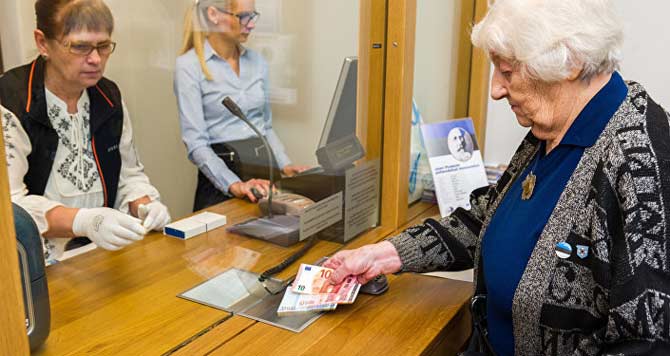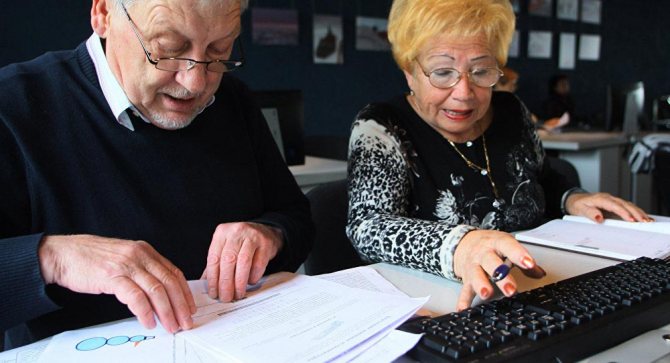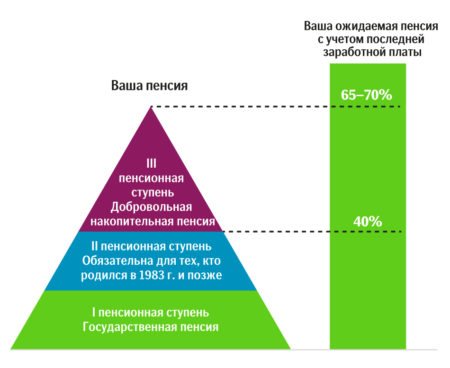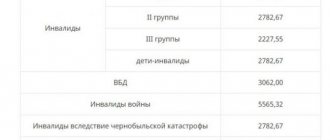The aging of the working population is a common problem in developed countries. That is why the system of joint pension provision, invented at the end of the 19th century, has ceased to meet new conditions, when the number of insurance premium payers is becoming smaller and there are more and more recipients of state benefits. One of the ways out of this situation is the introduction of a personal savings system. The Estonian authorities adopted the same principle as a basis: now pensions in Estonia are formed, among other things, through the mandatory funded part.
Types of pensions in Estonia
The Republic provides its citizens with the following types of pensions:
- State.
- by age (experience required);
- for disability, regardless of length of service;
- for loss of source of income (intended for disabled Estonian citizens);
- early retirement (when working in a production facility that does not allow working until retirement age);
- support pension (made 5 years after the age) in the absence of another type of accrual.
- Professional. The employer makes the payments. Such contributions can be either optional or forced.
- Voluntary. Contributions are made at the discretion of the future recipient of payments.
Types of benefits
To maintain social stability, the state must provide pensions to the disabled part of the population who have not reached retirement age and are physically unable to pay insurance premiums.
Types of benefits, depending on the circumstances of their assignment, are divided into several categories.
| Pension type | Administrative organization | Type of payment |
| State (1st level) | · old-age pension, including early, deferred and preferential; | |
| · loss of a breadwinner; | ||
| · for incapacity (disability); | ||
| · national pension (if a person has lived in the country for at least 5 years, but has no insurance coverage); | ||
| · parental allowance for raising children (for each child born since December 31, 1980) | ||
| Cumulative (2nd stage) | (mandatory in Estonia) | 6% of accrued wages are accumulated monthly in the account of the future pensioner, opened in one of the non-state pension funds. |
| Money can only be received after receiving the right to an old-age pension | ||
| Additional storage part (3rd stage) | Insurance companies and banks of the employee's choice | Accumulated premiums and earned premiums can be paid at any time starting at age 55. The payment can be monthly or issued one-time (at the client’s request). |
Retirement age
The retirement age for men in Estonia in 2020 reaches 63 years.
For the female half of the population, determining this age is more complicated. It depends on the date of birth .
- Those born in 1951 have the right to retire starting from the age of 62, from 1951 to 1953 - from 62.5 years, in 1953 - from 63 years.
In 2020 The Estonian authorities decided that the female half of the population, born from 1954 to 1960, have the right to retire from 63 years or more.
The retirement age limit will gradually increase.
Blog
We are trying to help you fully adapt and want to ensure that you are not left with any gaps in information about how life works in our small but beautiful country. The topic of this material is the Estonian pension system.
Even if you are still young and beautiful, and it seems to you that retirement age is still very, very far away, it’s worth thinking about the future now. Of course, you can save money in a jar hidden in the attic or in a savings account, but one of the most reliable ways to provide for old age is the state pension insurance system.
About the pension system in Estonia
Let's start with the fact that in Estonia you can retire at age 65. The age limit is the same for both men and women - long live equality! When you reach retirement age, you can continue to work and thus earn additional income, or you can say that you've had enough, slam the door, and spend the rest of your life on your favorite hobby.
With an aging population, the number of people working is decreasing, and the number of dependents is growing (yes, yes, you too will sooner or later become the owner of this title, so no offense). The problem is how to ensure a decent old age? Of course, you can endlessly increase the tax burden. But in Estonia they realized that with such an ingenious approach, sooner or later the moment would come when there would be no one left willing to eke out a miserable existence until old age, and the last person leaving for a more reasonable state would have to turn off the light when leaving.
A three-stage funded pension system became a cunning response to the challenge. Part of your income upon reaching old age is guaranteed by the state, but the rest of the monthly income is entirely up to you. And although at first glance the system seems complex, upon closer examination it becomes clear that this is not so. Let's get to know her! You can find comprehensive information on the Pension Fund's home page, and we hope this material will give you a general idea of the Estonian social insurance system.
Source
And now a little more detail:
I pension pillar
The first pillar is the part of the pension guaranteed by the state. The Republic of Estonia is going to exist approximately forever, so everyone who has reached retirement age, lost a breadwinner, become disabled, and so on can count on it. Of course, there are nuances: you still have to earn this guarantee by working in the country for at least 15 years (officially, of course: we say a resounding “no” to salaries in envelopes). And at the same time, it is not necessary to be a citizen - the country values contribution to its economy.
Estonia is considered a tax haven - income tax and sales tax are relatively small compared to other countries. In vain! After playing with the salary calculator, you will understand that the country knows how, loves and practices indirect taxation. A third of the employer's costs for employing you go towards paying social security tax, the majority of which - two thirds or 20% of total costs - goes towards pensions, and about a third or 13% goes towards health insurance.
So the next time you ask for a small raise and see your boss rolling his eyes, don't be surprised: the cost per employee is really high. If you firmly decide to become a tax resident of democratic Estonia, you will have to obey this dictate (and where can you get off the submarine?). However, there is good news: having achieved the required length of service, upon reaching retirement age you will receive monthly payments even if you move to another country.
Why join the Estonian pension system? Pension indexation is carried out annually, but the size of state-guaranteed monthly payments upon retirement averages from 400 to 500 euros. Even against the backdrop of the Estonian government’s promises about a quick increase in state guarantees, let’s be honest – not a lot. Don’t rush to run, because, as we said above, the pension system in Estonia is multi-stage.
II pillar of pension
If you were born later than January 1, 1983, congratulations, you have become a hostage to another manifestation of the dictatorship of democratic Estonia - the second pension pillar. But, in fact, it's not as bad as it sounds. Quite the opposite.
As we have already mentioned, each person has the right to decide issues about providing for his old age independently - by putting money into a cache or savings account. The suspicious leadership of Estonia at one time decided that not everyone would do this and guessed that they could be forced to save money! At the same time, simultaneously turning every working person into an investor - this is the whole essence of the second stage.
Every month, your employer withholds 2% of your gross salary, Estonia adds another four percentage points from social tax to these funds, and all these funds are sent to the pension fund of your chosen bank accredited in the country (you do not have to be its client). Thus, qualified financial institutions become your personal brokers, who, by playing on the exchanges, increase your capital.
If you are afraid that the bank might accidentally get too carried away and burst, losing all your savings, it is not worth it. Savings are stored separately from other working capital of financial institutions, so even in the event of a sudden death of the bank, they will not be affected.
You can choose not only your “personal broker” - the bank - but also an investment strategy: from conservative to aggressive. The first promises stable profitability, the second - the opportunity to increase your capital to a greater extent (the risks of losing money in this case logically increase). At the same time, your shares have a cumulative effect - the more there are, the faster your savings grow.
If you do not want to pretend to be an expert in the field of finance and bet on one of the banks, the “operator” will be determined by lot. However, we do not advise leaving such an important decision to chance. When choosing a bank, read not only the terms of the agreement, but also the performance of pension funds - statistics are updated daily.
A couple of fateful decisions and that’s it: no more of your participation in financial management will be required. All you have to do is check the status of your savings from time to time on the Pension Fund home page. If at any point you get horrified and decide that the bank is not doing its job very well, you can transfer your shares - all or part - to another institution. Please note that you will have to lose some of your savings.
III pillar of pension
A special calculator will help you calculate the approximate amount of your old-age pension. If the result does not cause you anything other than annoyance, you can always weigh the possibility of joining the third pension pillar. According to its principle of operation, it repeats the second stage in everything, but at the same time it is voluntary. To join this third pillar, it is enough to conclude an agreement on voluntary pension insurance with any insurance company or open a bank account - financial institutions allow you to open special pension accounts. You determine the amount of contributions yourself.
Estonia is a thrifty country, which is also why it stimulates interest in the third stage. If your contributions to the third funded pension system are less than 6,000 euros per year, or less than 15% of your gross salary, then these expenses are exempt from income tax.
Your pension
So, what your pension will be is largely up to you. Having reached retirement age, you may decide that the part of the pension guaranteed by the state will be enough for you, and leave the savings of the second and third pillars to your heirs. Or go all-in and withdraw your accumulated funds at once - it’s up to you.
Waking up one fine day, you may think that waiting for retirement age is not about you, it’s time to spend the accumulated funds on a reasonable or not so reasonable purchase right now. We hasten to disappoint you: this trick will not work with second stage savings.
However, nothing is carved in granite. The Estonian government has decided that if a person wants to withdraw all his savings and spend them on movies, popcorn, a beautiful or not so beautiful life, leaving himself without savings for his old age, he cannot be prohibited from doing so. Changes are planned for 2021. No one yet knows what the pension reform will look like in detail; all that is known is that savings can be withdrawn in parts or in whole. Follow the news!
Of course, the restriction that is still in force regarding the savings of the second pillar does not apply to the third pillar: everyone understands that this is your honestly earned hard-earned money and you are free to withdraw money at almost any time.
Pension savings in another country
Let us remind you that in order to receive a pension guaranteed by Estonia, you will have to try a little and work for at least 15 years. Therefore, the question about the fate of pensions of other countries in which you had to live and work is by no means idle. If you work in the countries of the European Union, you can apply for a pension if you have at least one year of work experience. This is in general, but there are nuances.
Each state sets its own rules. Therefore, after working, say, 2 years in France, 5 years in Germany and another 4 years in Finland, you should contact the pension departments of these countries, find out about the conditions for paying a pension and be ready to prove your work experience. In this case, upon reaching retirement age, you will receive a pension from several states.
All these nuances are reflected in the set of rules for social insurance in the European Union. Iceland, Liechtenstein, Switzerland and Norway also participate in this program. Estonia has concluded similar bilateral social insurance agreements with Russia, Canada, Moldova and Ukraine.
Therefore, if you are a restless person who often changes your place of residence, be prepared to spend time studying social security laws. We understand that this is not a very exciting activity. But it’s still worth addressing these issues now, while you are young and energetic.
If you are a good IT specialist and dream of living in Estonia, a modern and prosperous European country, then contact us! Our professional recruiter Alexey will answer all your questions and tell you in detail about how to move to Estonia, find a job here and start a new life. Email for questions and resume –
Pension amount
The pension is formed from:
- The basic part is 162 euros.
- Experience share , calculated for work until the end of 1998.
- Insurance share . The amount of this payment is affected by length of service, presence of maternity leave, military service, time of full-time education above average and temporary disability. This payment is calculated for each citizen individually. In addition to these factors, the payment depends on how much tax the citizen has paid since the beginning of 1999.
Important! Each year of service is reflected in a pension of 5.77 euros.

Every year in the spring, the country's government recalculates pensions. The amount of the pension payment is multiplied by an index, 1/5 of which depends on the annual rise in prices, and the rest on the growth in the social tax share. After such recalculation, the pension is paid starting from April 1.
Average pension
The average pension payment in the republic is 391 euros (24,027 rubles). The amount of the final payment is affected by length of service, pre-retirement income or participation in programs.
If the accumulated experience is 15 years, then a resident of Estonia receives 223 euros, 30 years - 301 euros, 40 years - 354 euros, over 44 years - 375 euros.
In 2020, the Estonian authorities plans to raise pensions by 5.7%.
Minimum pension
If a person has no work experience, then he is entitled to a national pension .
Currently, the minimum pension for an Estonian citizen is 158.37 euros.
Early and deferred retirement
A full age pension is only available to those who have officially worked and paid insurance premiums in Estonia for at least 15 years. The assignment of an old-age pension cannot be canceled, even if the pensioner continues to work.
In Estonia, it is possible to take a well-deserved rest before reaching

retirement age. Early retirement comes three years ahead of schedule. Those who meet the following conditions can enter it:
- lack of official employment or self-employment with income generation;
- there are three years or less left before reaching retirement age;
- The insurance period accumulated in Estonia is 15 years or more.
In case of early termination of employment, the benefit amount is reduced by 0.4% for each missed month (even incomplete). Thus, for a person who declared a desire to receive a pension 11 months earlier, the monthly pension will be cut by 4.4%.
Deferred retirement (applying for benefits later than reaching the legal age) is encouraged by the authorities, as it reduces the burden on national funds. As compensation, the state offers a proportional increase in the amount of monthly payments.
If a person postpones the date of retirement, the old-age pension in Estonia will increase by 0.9% of the originally assigned amount for each month of deferment. For example, for 2 years of work after reaching retirement age (provided that the length of service is sufficient for full payment), the pension amount will increase by 21.6%.

In addition, Estonia has retained the right to early retirement for persons employed in industries with hazardous and hazardous working conditions. Retirement in Estonia can be postponed to an earlier date, which depends on the area of employment and the employee’s profession:
- specialists listed in list No. 1 of ;
- for 5 years - representatives from list No. 2 of the same Resolution;
- regardless of age, but based on the accumulation of the required professional experience, if the person is employed in one of the positions listed in the Law “On Long Service Pensions” ( ).
| Employment type | Minimum work experience (total), years | Minimum experience in the profession, years | Retirement date |
| List No. 1 | 20 | 10 | 10 years ahead of schedule |
| List No. 2 | 25 | 12.5 | 5 years before reaching retirement age |
| Work in the police, security organizations and prison | 25 | 12.5 | Regardless of age, if the conditions for length of service are met |
| Mining workers | 25 years for above-ground work, 20 years for underground | ||
| Service on sea and river vessels | 25 years of work in the navy or river fleet | ||
| Employment in the textile industry | 25 years of work in the profession | 5 years earlier than the general retirement age | |
| Workers in education and organizations caring for the sick and disabled | 25 years of teaching experience or 15 years of work in special institutions | Regardless of age, if the conditions for length of service are met | |
| Art workers | 20 years for ballerinas, dancers and circus performers, 25 years for soloists, choir singers and puppeteers | ||
| HIV-infected healthcare workers | Upon the fact of infection, if it occurred as a result of performing professional duties | ||
| Public transport workers | 25 years, provided that the employee worked as a bus, tram or trolleybus driver in a city with a population of 400,000 people or more. | 5 years earlier than the established retirement age | |
Pension schemes
Payments in Estonia are calculated according to several schemes:
- Pension upon retirement
The payment is made from available funds in the account or from the capital of “today’s” taxpayers. The scheme is not very relevant, since the population is decreasing and creating a negative increase.
- Pension with specified contribution
It implies the assignment of an exact amount of regular contribution to the pension fund (percentage of income), which is not guaranteed and depends on the duration of the scheme.
- Scheme with assigned payment amount
Based on a specified retirement benefit amount. Contributions depend directly on the desired result, length of service and salary during the pre-retirement period.
- Payments
Depends on the amount of savings at the time of reaching retirement age.
Benefit calculation procedure
Periods when a specialist worked part-time or part-time are not counted towards professional experience. Payments stop if the specialist decides to resume work in one of the preferential industries.

Taking into account the reforms carried out, a working person should now think about what kind of pension in Estonia will be paid to him after completing his professional career. The Law “On State Pensions” determines that the amount of old-age accrual consists of three parts:
- Basic (basic) - fixed for all categories, taking into account annual indexation from April 1, 2020, amounts to 191,649 euros per month.
- Proportional - depends on the accumulated total length of service until December 31, 1998, multiplied by the cost of the insurance year: the number of years worked before 1999 is multiplied by the annual assessment rate - from April 1, 2020 it will be 6,627 euros for each year of work.
- Insurance – the number of years of payment of social tax, multiplied by the current annual assessment (in 2020 – 6,627 euros).
The Social Insurance Department has developed it for those who want to make a calculation in advance and find out how much their future pension will be.
The benefit accrued upon retirement is subject to annual indexation. For example, the average pension in Estonia in 2020 increased by almost 7% from April 1 (from 447 to 481 euros per month). The national pension from April 2020 is 205.21 euros.
The funded portion is paid in accordance with the provisions of the agreement signed with the pension fund or insurance company. This can be a pension agreement with a lifetime annuity or a payment for a certain period, when the amount paid during life is divided by the number of years of survival (the minimum period is 10 years) and added to the state benefit.
If the accumulated amount is less than the national pension multiplied by 10 (if a pension is assigned in 2020, this is 2052.10 euros), then the applicant can request a lump sum payment.
Funds transferred to the pension fund as part of participation in the second and third pillars of insurance are legally protected from the risks of bankruptcy of the organization or termination of its activities for other reasons.
The amount of shares of 10,000 euros is guaranteed to be returned, and the part exceeding this amount will be refunded using a coefficient of 0.9. That is, from a share of 20,000 euros, the investor will be returned 10,000 euros guaranteed and 9,000 euros using a reduction factor.
Pensions in Estonia for Russians
This year, the pension for Russians living in Estonia is 312 euros .
Many citizens seek to go to other European countries to earn money. The outflow of young people is so large that pensioners make up almost half of the population of Estonia.
Because of this state of affairs, the retirement age for Russian citizens can be raised to 74 years, and the length of service to receive a pension can reach 44 years. Only in this case the payment amount can increase to 396 euros.
When calculating the pension, the day of the month when the application for receiving it is submitted is taken into account. The initial payment includes the amount of unpaid funds from the date of application. Thus, a person receives a payment in the amount of a pension for several months.
Types of payments for pensioners
- Old-age payments: upon reaching age, there are still three years before payments, upon retirement after reaching age.
- Payments in connection with the loss of a breadwinner.
- Payments due to decreased ability to work.
- Pay upon reaching age, but in the absence of experience.
- Preferential payments.
Important! Tax is withheld from payments received by Estonian pensioners - 154 euros per month. Income that is not subject to taxation per year is 2,640 euros.
State pensions
- old age pension – you have reached retirement age;
- early old-age pension – you have not yet reached retirement age, but there are less than three years left until retirement;
- deferred old-age pension – you want to retire later than the old-age pension age;
- old-age pension on preferential terms - you raised a disabled child or three or more children and want to retire early;
- survivor's pension – one of your family members has died;
- disability pension – your ability to work has decreased;
- national pension – you have reached the age of old-age pension, but you do not have any pension experience.
National pension
You are entitled to receive a national old-age pension if all of the following conditions are met:
- you have reached old age pension age;
- you do not have the required pension period to apply for an old-age pension;
- you have lived in Estonia for at least five years immediately before applying for a pension.
You are entitled to receive a national pension also in the event of loss of a breadwinner, if all the following conditions are met:
- the deceased family member did not have the pension experience necessary to apply for a pension;
- the deceased family member lived in Estonia for at least one year immediately before applying for a pension.
The national pension rate as of April 1, 2019 is 205.21 euros.
Preferential pensions by area of professional activity
- List No. 1 and No. 2 – you worked in a profession that is harmful to health;
- long-service pension - you performed work that, after a certain age, no longer allows you to continue to hold this position;
- police officer's pension – you worked as a police officer;
- prosecutor's pension - you worked as a prosecutor;
- serviceman's pension – you were a serviceman/soldier;
- judge's pension – you worked as a judge;
- State Audit Office pension – you worked at the State Audit Office;
- Pension of the Legal Chancellor - you worked as the Legal Chancellor or Deputy Advisor to the Legal Chancellor.
Important! Payments are required to increase by 5.7 euros for each year worked.
Long service pension
You are entitled to a long service pension if you have worked in a profession that, before reaching old age pension age, entails a loss or reduction in your ability to work, due to which you can no longer work in that profession or position.

The following have the right to receive a long-service pension:
- police officers, rescue workers, and prison officers;
- civil aviation workers and test pilots;
- underground and surface mining workers;
- workers of the sea and river fleet, as well as the fishing fleet;
- textile industry workers;
- teachers of orphanages, educational institutions for persons with special needs and children's institutions for sick children;
- artists of state, municipal and private theaters and theatrical institutions operating as a target institution, as well as the National Opera;
- healthcare workers infected with HIV;
- public transport drivers working on regular intracity lines (in this part there are links to a specific additional page for each specialty).
Survivor's pension
If someone in the family dies, family members can apply for a survivor's pension.

You can receive a survivor's pension if you are a deceased family member:
- a child under 18 years of age or under 24 years of age when studying in a full-time form of education;
- widower/widow with reduced ability to work;
- widower/widow of old age pension age;
- a parent at old age pension age;
- a parent with reduced ability to work;
- an unemployed and pregnant widow;
- a non-working parent or guardian of a child under three years of age.
You will receive a survivor's pension only if the deceased family member had a pension experience of the required duration (link to the page “Pension experience”), the duration of which depends on his age at the time of death.
| Age | Required retirement experience |
| from 16 to 24 years old | 0 years |
| from 25 to 26 years old | 1 year |
| from 27 to 28 years old | 2 years |
| from 29 to 30 years old | 3 years |
| from 31 to 32 years old | 4 years |
| from 33 to 35 years old | 5 years |
| from 36 to 38 years old | 6 years |
| from 39 to 41 years | 7 years |
| from 42 to 44 years old | 8 years |
| from 45 to 47 years old | 9 years |
| from 48 to 50 years | 10 years |
| from 51 to 53 years old | 11 years |
| from 54 to 56 years old | 12 years |
| from 57 to 59 years old | 13 years |
| from 60 to 62 years old | 14 years |
If a person died due to a workplace injury or occupational disease, pensionable service is not necessary.
Disability pension
A disability pension is received by persons who have an expert decision on loss of ability to work, i.e. the person is unable to earn a living through his work, or this is difficult.
Loss of ability to work can be complete (100%) or partial (from 10 to 90%). A disability pension is paid if the degree of loss of disability is from 40 to 100%.
Transfer of pension from Estonia to Russia
Estonia and Russia have concluded an agreement on mutual support for pensioners. In both countries, the amount of this payment directly depends on the length of service obtained in the territory of each state separately.
If in retirement a person moves from Russia to Estonia or vice versa, then the cash payment to him is made by the country that accumulated the funds.
Estonian citizens who find themselves in Russia are deprived of the national part of the pension, but receive the right to benefits from Russia.
The disadvantages of such a move include:
- lack of a pension for the loss of a working family member;
- When funds are credited to a bank account, euros are converted to rubles. Due to the difference in the exchange rate and the bank's interest rate, a certain amount of money is lost for servicing.
The pension is paid in a specialized institution on the 20th day of every second month of the quarter. The currency exchange rate corresponds to the Central Bank.
Absolutely all pensions paid to citizens abroad are subject to income tax; there are no exceptions.
Estonian pension system
A pension is a payment in the event of old age or disability, as well as in the event of the loss of a breadwinner. The purpose of a pension system is to provide a monthly income to a person who has retired.

The pension system has a three-tier basis:
1st stage
First stage payments constitute the minimum subsistence level. State pensions depend on the amount of taxes that come from the payments of the working population. As is the case throughout the world, the number of working-age people is becoming smaller and smaller.
2nd stage
Payments from this stage are made up of personal contributions, from which 2% is withheld monthly. The state adds its 4% to this percentage. And the result is 6%, which a person receives while retired. The greater the salary a citizen receives, the greater the deductions, the greater the future payments.
Being in the second stage is mandatory for those born after 1982. If a person, having reached the age of 18, could not independently decide which fund his income deductions will go to, then the state itself will take care of this. The choice is made by drawing lots.
3rd stage
Here a person independently decides on the amount of deductions. For normal existence, future payments should be 65% of income. The first two levels will give 40%, and the remaining % will be collected by the future pensioner himself.
The total amount of the benefit is calculated as the base amount (160 euros), bonuses for the length of service worked before 01/01/1999 and the amount of the insurance share. Each pension applicant has its own specific calculations.
Prospects
In the future, the Estonian authorities plan to radically change the pension system of the republic. Payments will be such that pensioners no longer need anything. Pension income must be sufficient for normal living in the country.
Residents of the republic will be given the opportunity to independently choose the time of retirement, make partial payments, freeze them and resume them.
The retirement age will correspond to life expectancy, and may reach 70 years. The proposed changes will not affect current citizens of retirement age and accumulated shares.
Watch the video: Estonia is going to pay pensions to citizens living abroad.
Pensions in Estonia are formed from a number of important points, which become stricter every year, but affect the amount of payments. And if, after working in the republic for some time, a person decides to move to Russia, it is recommended to have impressive work experience in the territory of the pension fund.
General characteristics
Estonia has not completely abandoned the solidary system of pension payments. As a result of the reforms carried out, the country’s pension system consists of three stages:
- Compulsory state insurance. Formed from funds received from the payment of social tax: 33% of the wage fund of officially registered employees. From 16 to 20% of the transferred contributions are allocated to current payments to modern pensioners. At the expense of jointly accumulated funds, state benefits are paid to disabled people, people who have lost their breadwinner, old-age pensions for permanent residents of Estonia and foreigners staying in the country with a residence permit, as well as the national pension in Estonia (provided for those who do not have the opportunity to confirm their insurance period).
- Mandatory savings part. Additional personalized contributions are formed from two sources: 2% of the accrued salary is paid by the future pensioner himself, 4% is paid additionally by the employer (as part of 33% social tax). Not everyone can join this system automatically. The main condition is that the payer cannot be older than 1983, the rest had to declare their desire to pay contributions before 2010.
- Additional (voluntary) funded part. Until 2010, a person born between 1942 and 1982 could still join in paying mandatory funded contributions. After October 31, 2010, this option is no longer available, so those who do not want to be satisfied with the state pension (it is no more than 40% of average earnings) must pay additional savings pension contributions on their own. Participation in the third pillar of pension insurance allows you to increase the size of your future pension to 65–70% of your current salary.
The Estonian pension system is based on several regulations:
- “On state pension insurance” - ;
- “On preferential old-age pensions” - ;
- “On funded pensions” – ;
- “On social tax” - .
From the important point: from January 1, 2020, the country began the process of gradually increasing the retirement age (by 2026 it will increase to 65 years), various types of benefits are used - three stages. Early and deferred pensions are also applied, and delayed retirement is financially encouraged.
How much do older Estonians earn?

In order to understand what a pension is in Estonia, you need to know what it is formed from. These are three main components.
Firstly, the basic part, which currently amounts to 162 euros (about 11,800 rubles). Secondly, this is the so-called length of service, which is accepted as work activity until the end of 1998. Thirdly, this is an insurance share. This payment is directly influenced by length of service, as well as the presence of maternity leave, time spent in full-time education above average, completion of military service, and temporary disability for a valid reason.
In Estonia, such a payment is calculated individually for each citizen. By the way, in addition to the above factors, the payment itself will also depend on how much tax has been paid by the citizen since 1999.
The government of this republic recalculates pensions every year in the spring. In this case, the existing pension is multiplied by a certain value, a fifth of which directly depends on the rise in prices over the past year. The rest (this is 4/5) is affected by the increase in social tax. After this recalculation, from April 1, the pension is paid at the new rate.
Average standard of living of older Estonians
In order to visualize the size of the pension in Estonia, let’s calculate how much the average citizen gets on average. The average pension here is 391 euros (about 28.5 thousand rubles). This is the average pension in Estonia. The final amount is greatly influenced by pre-retirement income, length of service and participation in government programs. Now you know how much the pension is in Estonia.
For example, if your experience was 15 years, then you will receive 223 euros (about 16 thousand rubles), if you worked twice as long, then 301 euros (about 22 thousand rubles), if you worked for 40 years, you will receive 354 euros (almost 26 thousand rubles), and if you are over 44 years old, then your monthly pension will be 375 euros (about 27.5 thousand rubles).
At the same time, the annual increase in pensions is about five percent.
The minimum pension in Estonia is called the national pension. It is entitled to any citizen of the country, even if he has no work experience. Currently, the minimum pension in Estonia is 158 euros (this is around 11.5 thousand rubles).











